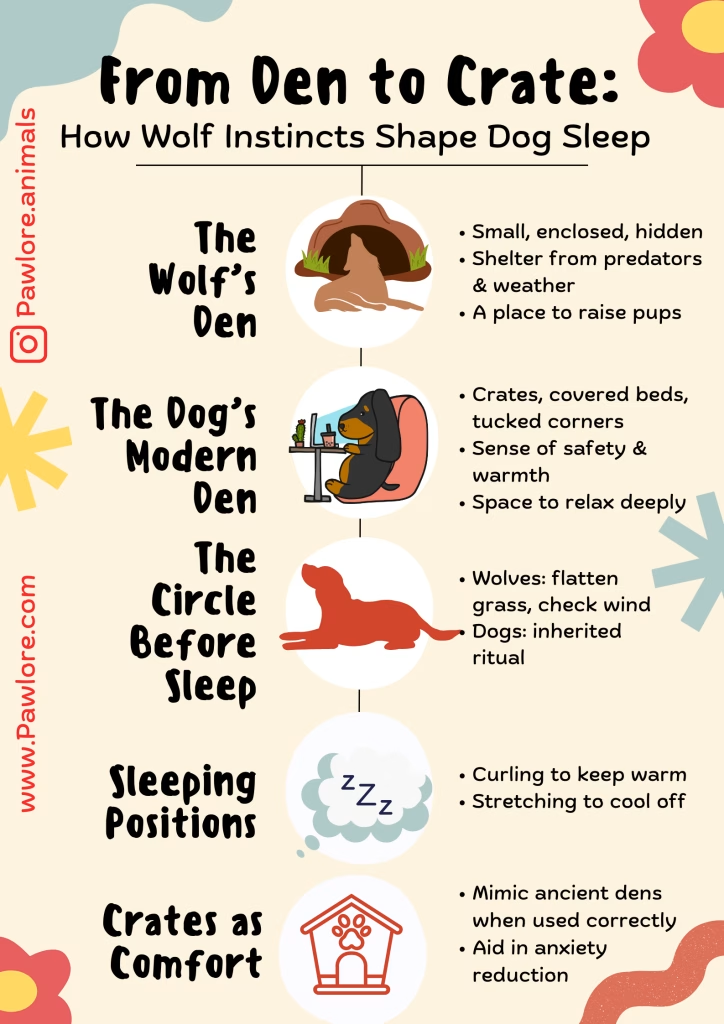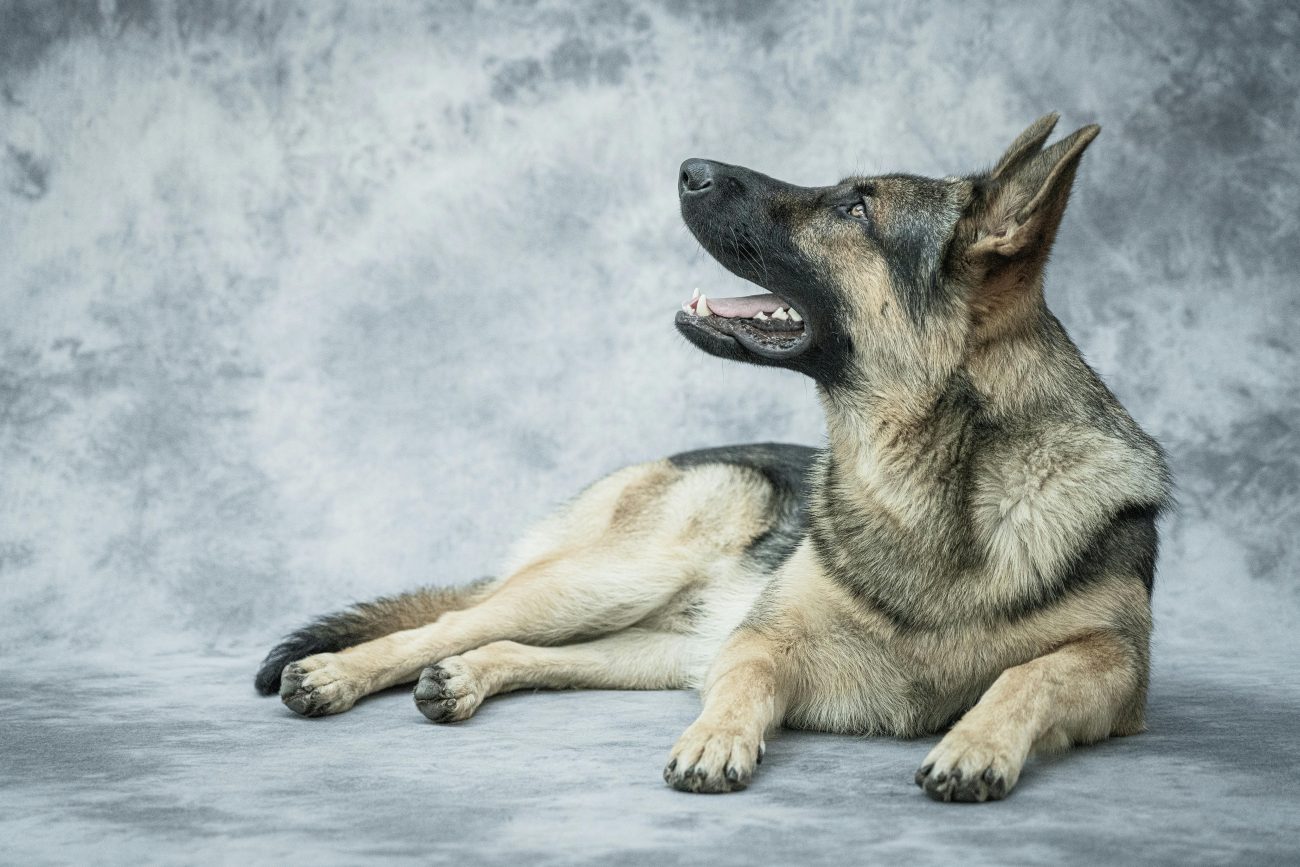A Cozy Corner in the Modern World
It’s late evening. You’ve just turned off the kitchen lights, and your dog quietly leaves the living room. You find them curled up inside their crate, under the coffee table, or in a favorite corner, eyes half-closed, paws tucked beneath them. To you, it’s a cute nightly ritual. To them, it’s survival instinct unchanged in spirit since the days when wolves slept in the safety of earthen dens.
Even after thousands of years of living alongside humans, dogs have kept many of the sleeping habits of their wild ancestors. From the spots they choose to the way they curl their bodies, these behaviors are echoes of a time when safety, warmth, and protection from predators were essential to survival.
Wolves and the Safety of the Den
In the wild, wolves don’t rest just anywhere. They choose specific, sheltered spots, dens dug into hillsides, hollows under fallen trees, caves in rocky terrain. These spaces protect them from weather, hide them from predators, and give them a safe place to raise pups.
The den is more than shelter. Inside, they are less exposed to threats, and the structure itself acts as a physical and psychological shield. The walls of the den muffle sound, block wind, and make it harder for danger to approach unseen.
Even wolves that spend most of their time traveling and hunting will seek sheltered spaces to rest. The instinct to find protection before sleep is deeply ingrained, because in the wild, sleep is the most vulnerable state of all.
Why Dogs Still Seek Enclosed Spaces
Your dog may live in a house with locks, central heating, and no predators in sight, but their brain doesn’t know that. The pull toward small, enclosed areas (a crate, the space under a desk, a corner behind the couch) is the same pull their ancestors felt toward a den.
To a dog, an enclosed space is security. Walls or coverings around them create a “barrier” that makes it easier to relax fully. They don’t have to monitor every direction at once; their back is covered, and their field of focus is reduced. This allows for deeper, more restorative rest.
The Circle Before the Curl
Perhaps the most visible connection between wolves and domestic dogs is the pre-sleep circling ritual. Wolves circle to tamp down grass or snow, check the ground for hidden dangers, and position themselves with the wind so they can detect approaching threats. Domestic dogs still circle before lying down, even on a perfectly smooth carpet or a plush bed.
They don’t need to flatten grass or align to the wind anymore, but the behavior is wired into the pre-sleep sequence. It’s like muscle memory passed down through generations, a silent link to a life that was once much harder.
Temperature, Comfort, and the Wild Connection
Wolves adapt their sleeping positions to the seasons. In winter, they curl tightly to conserve body heat, often tucking their noses under their tails. In summer, they sprawl on their sides or backs to release heat. Domestic dogs do the same.
If your dog curls into a compact “donut,” they’re conserving warmth. If they stretch out with their belly exposed, they’re cooling down. And when they paw at blankets or dig at bedding before settling, they’re mimicking the way wolves arrange materials in the wild for insulation and comfort.
How Crates Tap Into Ancient Instinct
When introduced correctly, a crate is a modern den. Many dogs, once crate-trained with positive methods, will enter their crate willingly. They may even prefer it at bedtime or during stressful moments like thunderstorms.
The crate satisfies a deep instinct: the need for a safe, enclosed space that belongs entirely to them. Just as a wolf knows the boundaries of its den and trusts it as a place of refuge, a dog learns to associate its crate with comfort and safety.

Social Sleeping and Pack Bonds
In a wolf pack, sleeping arrangements reinforce relationships. Wolves sleep close to those they trust most, with pups and pack leaders often nestled at the center. Sleeping proximity helps maintain social bonds and strengthens group cohesion.
Domestic dogs also exhibit this natural behavior. That’s why many prefer to sleep in the same room as their humans, even if they have their own bed. It’s not just affection; it’s pack logic. By sleeping near you, they combine the safety of the den with the reassurance of the pack.
Signs Your Dog Feels Safe When Sleeping
A relaxed sleeping dog will often show small signs of trust: exposing the belly, stretching out without keeping the head raised, or entering deep REM sleep (twitching paws, dream movements). These behaviors mean they feel secure in their “den,” whether it’s a crate, bed, or a corner of the room.
On the other hand, frequent position changes, sleeping in doorways, or resting with eyes partially open can suggest your dog is staying alert, a leftover habit from wolves needing to be ready to respond to danger.
When Restlessness Signals Something More
If your dog can’t seem to settle at night or keeps changing sleeping spots, it may be a sign that they don’t feel entirely secure in their chosen space. This could be due to environmental factors (noise, temperature, lighting) or emotional factors like anxiety.
In the wild, a restless wolf might relocate repeatedly until finding the right den. In the home, you can help by offering multiple sleeping options, placing beds in quieter spots, or using a crate with a cover to reduce visual and auditory distractions.
Creating the Perfect Modern Den
Supporting your dog’s ancient instincts doesn’t mean recreating a wolf’s hillside burrow, but it does mean understanding what they value in a resting place. Provide a spot that is soft, enclosed on at least one side, and located away from heavy foot traffic.
For anxious dogs, consider placing their den near you so they get both the shelter of the den and the reassurance of your presence. As the AKC advises, Avoid forcing them to use a specific bed or crate; let them choose. Once they find “the spot,” keep it consistent.
The Ritual That Hasn’t Changed
It’s easy to think that domestic life erases the wild. But when your dog disappears into their crate at night, circles three times on a blanket, or curls tight with their nose under their tail, they’re following a script written long before humans built homes.
In those moments, they are more than pets, they are the descendants of wolves, carrying ancient knowledge in every movement. The den is still there, even if its walls are made of fabric and steel instead of earth and stone.
Wolves at Rest, Dogs at Home
Your living room may be miles from the nearest forest, but the natural urge that drives your dog to seek a safe, enclosed sleeping spot is timeless. The den (whether dug into the side of a hill or lined with fleece) remains a sanctuary.
When you see your dog retreat to their crate or curl into their bed, you’re not just watching a pet getting comfortable. You’re watching history breathe. The wolf still sleeps there, dreaming in the heart of your dog.
Love uncovering your dog’s wild side? To learn more about the bedtime ritual inherited from their ancestors. You can also dive into Pack Behavior in Dogs: What Pet Owners Miss About the Wild for insights on how social instincts still shape your dog’s daily life, or see how ancient feeding habits survive in Natural Feeding Routines for Dogs Based on Wolf Packs.


